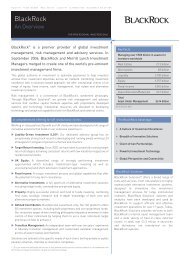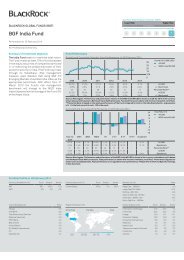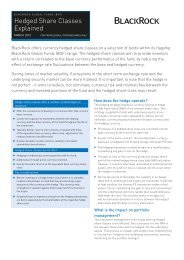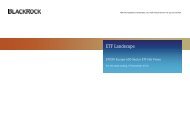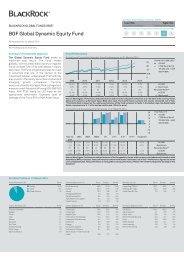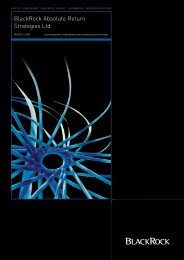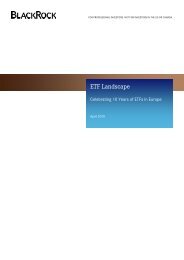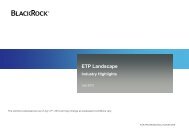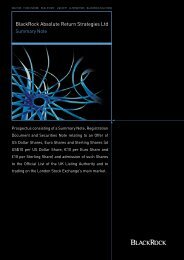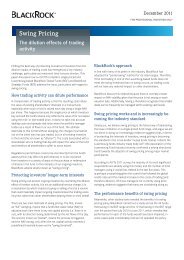ETF Landscape: United Kingdom Industry Review - BlackRock ...
ETF Landscape: United Kingdom Industry Review - BlackRock ...
ETF Landscape: United Kingdom Industry Review - BlackRock ...
You also want an ePaper? Increase the reach of your titles
YUMPU automatically turns print PDFs into web optimized ePapers that Google loves.
<strong>ETF</strong> <strong>Landscape</strong> Year End 2010<strong>United</strong> <strong>Kingdom</strong> <strong>Industry</strong> <strong>Review</strong> from <strong>BlackRock</strong>Commodities in your portfolioPortfolio diversification: commodity returns have historicallydisplayed low correlation with equities or other asset classes.As equities and other traditional assets perform well, commoditieshave tended to underperform these asset classes. However, asother asset classes decreased in value, commodities havesometimes provided positive returns for investors. Commodities areoften used to help reduce portfolio risk by adding diversification.Potential portfolio protection: historically, commodities are oneof the few asset classes to have benefited from rising inflation.As demand for goods and services increases, prices of those goodsand services usually also rise, as do the prices of the commoditiesused in their production. Because commodity prices tend to rise inperiods of inflation, investing in commodities can potentially providesome portfolio protection against accelerating inflation.Indices are a convenient way to access a group of commodities.Indices can represent the asset class as a whole or a particularsub-sector, such as energy, agriculture or precious metals.Commodity indices differ in the rules used to gain exposure to theasset class. Does the index track futures prices or spot prices? Howoften is the index rebalanced? Are there minimum and maximumweightings for different sectors or individual commodities? Investorsshould be aware of these rules before investing in structuredproducts linked to indices. This section describes the componentsand methodologies of some of the main commodity indices. Someof the key features are outlined below.In addition, commodities have often proved more resilient thanother asset classes to geopolitical and macro-economic shocks.For example, political crises in emerging markets have sometimestripped up stock markets but left the commodity marketrelatively unaffected.Figure 30: S&P GSCI USD TR Index versus MSCI World USD TR300%250%200%150%100%50%0%300%250%200%150%100%50%0%-50%-50%Jan-96 Apr-97 Jul-98 Oct-99 Jan-01 Apr-02 Jul-03 Oct-04 Jan-06 Apr-07 Jul-08 Oct-09 Dec-10S&P GSCI TRMSCI WorldNote: Index returns are for illustrative purposes only and do not represent actual fund performance. Index performance returns do not reflect any management fees, transactioncosts or expenses. Indices are unmanaged and one cannot invest directly in an index. Past performance does not guarantee future results. Data as at year end 2010.Source: Global <strong>ETF</strong> Research and Implementation Strategy Team, <strong>BlackRock</strong>, Bloomberg.This document is not an offer to buy or sell any security or to participate in any trading strategy. Please refer to important information and qualifications at the end of this material. 28



